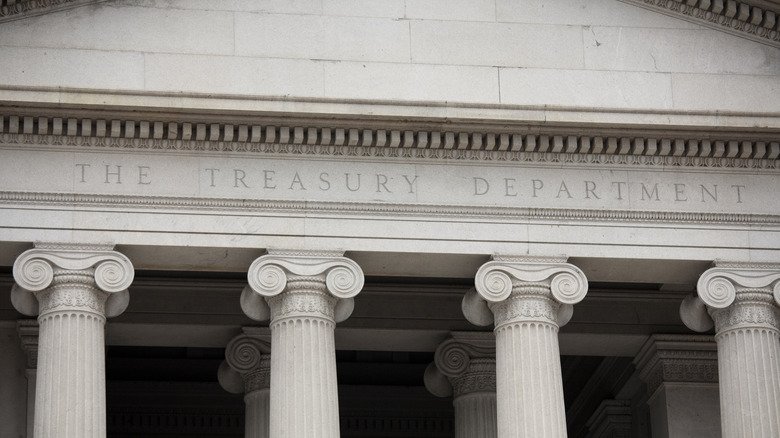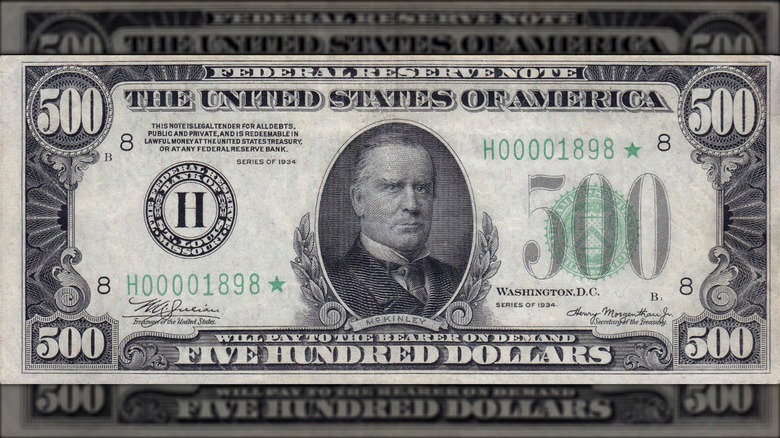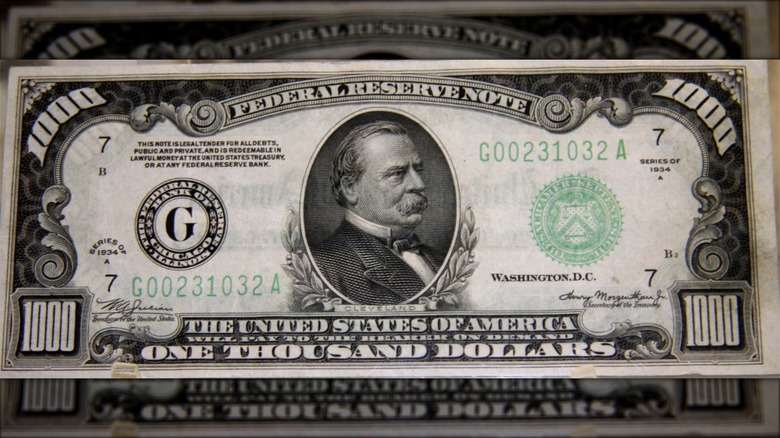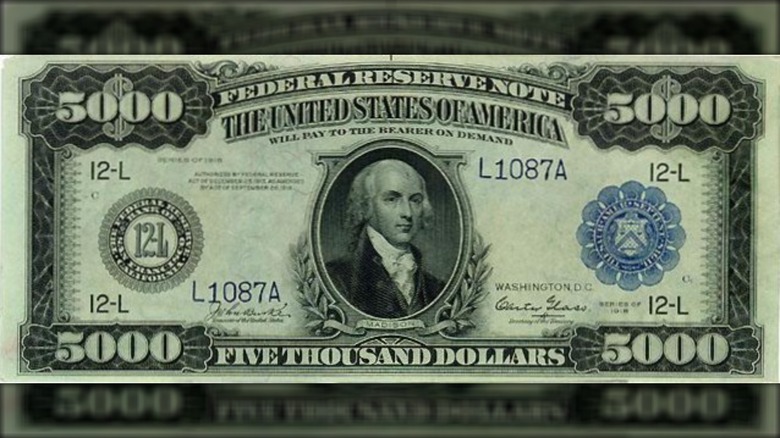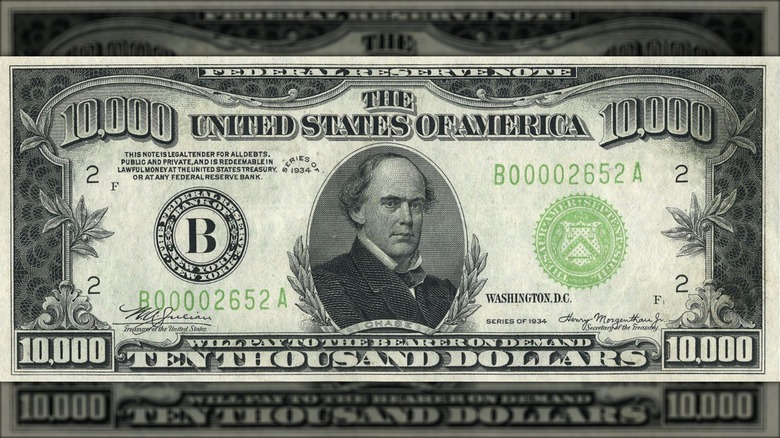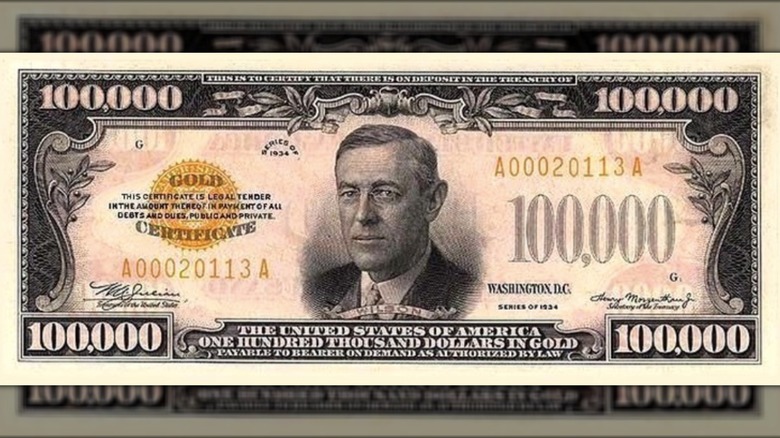Why The US Government Once Printed A $100,000 Bill
From online transfers to mobile deposits to apps like Venmo and CashPay, it often feels like carrying cash will soon be a thing of the past. However, for much of America's history, printed currency was the key way to pay for goods. In fact, the original 13 colonies used paper notes to pay for expeditions long before the U.S. was even a country.
In 1861, the first pressed paper money entered circulation in the U.S. Even though the first issued denominations were $5, $10, and $20 Demand Notes (also called greenbacks), there were many different iterations of bills (and denominations) in the years to follow. In fact, the process featured everything from fractional currency notes (for instance, paper money representing five cents), half-cent coins, and even varying bill colors and sizes. It wasn't until 1929 that the Federal Reserve created the standardized design for U.S. banknotes that we use today.
Even though the largest paper money denomination today is the $100 bill, did you know that $500, $1,000, and even $5,000 bills were technically still in circulation until President Nixon had them recalled in 1969? The U.S. even made a $100,000 bill at one point, despite the fact that the net worth of average Americans during most of the printing times for these large bills was considerably lower than the currency amount. With that in mind, many of these bills would actually better serve modern society than they ever did for Americans in the early 20th Century. So, why did these bills disappear?
The $500 bill
Most currency bills of a large amount were created for inter-bank purposes, as a way for banks to exchange and move funds in a world before online banking. With that in mind, some of these bills did find use in public circulation (albeit not as commonly). Ultimately, all bills with a currency amount above $100 were recalled by President Nixon in 1969 largely due to fears over potential money laundering schemes. However, their lack of use, coupled with inflation were definitely also factors in their discontinuation (not to be confused with why the U.S. no longer regularly prints $2).
For instance, if you compare the Consumer Price Index (CPI) from 1969 (which was approximately 36.8) to the September 2023 rate (303.8), a person today would need to use a $1,000 bill in order to pay for something that would have cost them only about $100 in 1969. This decision came just a few years before the U.S. abandoned the gold standard and changed the way our currency was valued.
Even though these large bills were still being issued until 1969, the last time any of them were physically printed was in 1945. With that being said, all denominations of notes from 1914 to today remain valid and redeemable as U.S. currency (although it goes without question that a $500 note would fetch a lot more than its face value today). The $500 bill features a portrait of the 25th U.S. President William McKinley, who was assassinated early into his second term.
The $1,000 bill
The $1,000 bill went through a LOT of portrait changes. With that being said, it is most well-known for featuring a rather unique U.S. President. President Grover Cleveland is still the only president to have served his terms non-consecutively (as the 22nd and 24th President). He's also the only bachelor President to get married in the White House (and have a child during his term). Interestingly, Grover Cleveland's portrait was actually originally featured on the $20 bill (from 1914 to 1929) before his portrait was replaced with Andrew Jackson. Jackson, whose portrait had, up until then, been featured on the $10,000 bill (he was replaced on that bill with Salmon Chase after being moved).
The portrait situation gets even more confusing when you realize that the originally issued $1,000 bills actually had Alexander Hamilton featured on it (Hamilton's is considered the Blue Seal version of the bill to Cleveland's Green Seal version). However, as Hamilton was also featured on the $10, it was too confusing to have the same portrait on multiple denominations, hence the initial swap. Despite the portrait changes, the $1,000 bill suffered the same fate as other large denominations in being recalled and discontinued in 1969. The bill was mainly used for inter-bank exchange and purchases, rather than for public circulation. A rare 1891 version of the $1,000 bill (this one featuring William Marcy) sold for $2.6 million in 2013 and holds the record for the highest price ever paid for paper money.
The $5,000 bill
Printed in 1918, the $5,000 bill was, like many other large denomination bills, not created with the intention of public circulation, but rather for use in inter-bank transactions. As a result, it was never a common bill that average Americans would have seen let alone have and/or use themselves, but that didn't stop them from getting into the hands of collectors. The bill features James Madison, fourth President of the U.S. and "Father of the Constitution" alongside a blue seal.
Madison had no direct link to anything financial, and was selected for this bill based purely on his role in writing America's founding documents. The back of the bill features a very detailed image of George Washington resigning his commission as commander-in-chief of the Continental Army in 1783. The $5,000 bill remains one of the rarest notes for collectors and it's estimated only a few hundred still exist today. In February 2023, one of these $5,000 notes sold for $270,250 at auction. Auction amounts for these historic notes largely depend on the condition of the bill itself, which, when you consider that these bills are only paper with relatively short lifespans, can be difficult to keep pristine. Plus, let's not forget how filthy our paper money can be.
The $10,000 bill
This is the largest bill that was ever created with the intention of public consumption and circulation. Of course, it's important to remember that, at the time, not many Americans had a large enough net worth to be able to regularly use a bill in this amount. As a result, the $10,000 was largely unused before being recalled in Nixon's 1969 anti-money laundering campaign. Even though they've been recalled, some still remain in circulation (generally with collectors). One of these $10,000 bills actually sold at a 2023 auction for $470,000.
Perhaps the most interesting thing about the $10,000 bill is the man featured on it after 1918 (before then, the bill featured Andrew Jackson). Unlike many bills that feature former Presidents, the $10,000 bill actually featured someone who lost two presidential bids — Supreme Court justice Salmon P. Chase. You might be wondering why this judge in particular, of the many in U.S. history, was chosen for this expensive banknote. The answer has to do with Chase's political career before he was a Justice. As the Secretary of the Treasury (for which he was hand-selected by then-President Abraham Lincoln) Chase was instrumental in creating our currency system, our first paper money (greenbacks), and in the foundation of the country's banking system through the creation of the National Currency Act and National Bank Act of 1864. Our modern financial system, and the core of how money is handled is the U.S. all goes back to Chase.
The $100,000 bill
The $100,000 was never publicly circulated, and as such was never officially considered currency. The bills were instead intended to transfer funds between different Federal Reserve Banks. The $100,000 Gold Certificate, Series 1934 notes (as they're more officially referred to) were only printed during the Great Depression from December 1934 through January 1935. Interestingly, they were only issued by the Treasurer of the U.S. against an equal amount of gold bullion held by the Treasury at the time. This means that, rather than normal banknotes, these functioned as gold certificates instead. Like with the $500, $1,000, $5,000, and $10,000 bills, these were ultimately discontinued in 1969.
The fact these bills were only ever intended for Federal Reserve Banks means that it is actually illegal for collectors to have one of these bills today. With that in mind, there are certain museums that have and display these bills, along with branches of the Federal Reserve System. President Woodrow Wilson appears on the note, alongside a large gold seal. If you're wondering why President Wilson was given the honor of appearing on the largest banknote ever printed by the Bureau of Engraving and Printing, it is largely due to the fact that he signed the Federal Reserve Act into law. This law is what actually created "The Fed" as we call it today, making Wilson's contribution to Federal Reserve Banks fairly obvious and his placement on these Fed exclusive notes extremely fitting.
